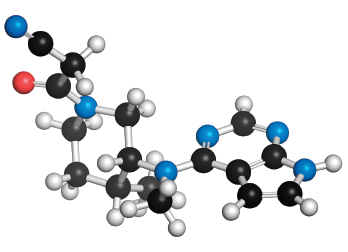
Tofacitinib, a rheumatoid arthritis drug.
MOLEKUUL / science source
CHICAGO—Amid what she called a “dizzying array of choices” for rheumatoid arthritis (RA)—from anti-TNF and anti-IL6-receptor therapies to B cell depletion to new biosimilar options—disease treatment should still revolve around several basic concepts, an expert said at the ACR State-of-the-Art Clinical Symposium in April.
Joan Bathon, MD, chief of rheumatology at Columbia University in New York City, laid out four main principles clinicians should use to guide their choices as new therapies march onto the RA landscape.
First, she said, early treatment should be the primary aim, to prevent damage and disability. “We want to start DMARD [disease-modifying anti-rheumatic drug] treatment as soon as you make the diagnosis—hopefully that’s within six weeks of either recognition of the symptoms or a definitive diagnosis,” she said.
Second, she said, “Treat hard.” In other words, treat patients with the maximum effective dose they can tolerate, with a rapid escalation of DMARDs.
Third, patients should generally be treated with a combination of DMARDs, when appropriate, because combination therapy is consistently more effective than monotherapy. “One thing’s for sure,” Dr. Bathon said. “If your patient has bad prognostic signs … you want to think about combination therapy.” Those signs could include a very high number of swollen joints; exceptionally high erythrocyte sedimentation rates, C-reactive protein levels, rheumatoid factor or cyclic citrullinated peptides; or erosions at baseline.
Finally, treatment should have a goal in mind—ideally remission, but at least low disease activity, Dr. Bathon said.
Lessons Learned
Lessons from the 2007 BeST study on early RA remain highly relevant, she said.1 The study evaluated several approaches, including a series of monotherapies, a step-up approach to combination therapy, a combination as initial therapy or a methotrexate-infliximab start. In each arm, remission was the goal, and treatment had to change every three months if a Disease Activity Score 44 (DAS44) of 2.4 or lower wasn’t achieved.
Improvements in signs and symptoms were seen regardless of the therapy and strategy, although radiologic outcomes were better with early combination therapy than delayed combination therapy.
These results hold a crucial lesson, Dr. Bathon said. “Goal-directed therapy is really optimal,” she said.
A sensible treatment algorithm, she said, is to start with methotrexate monotherapy unless it’s contraindicated, and then add a second DMARD if the response isn’t good enough. If you see residual disease activity, she said, add a nonbiologic or a biologic therapy depending on the severity.
“My mantra here is to make the punishment fit the crime,” she said. “If somebody comes in with a couple of [affected] PIPs [proximal interphalangeal joints] and everything else is well controlled, I’m not going to add a $40,000 drug to control a couple of PIPs. I’m going to add something like hydroxychloroquine.”
Which second DMARD should you add when methotrexate proves inadequate? Answers could come from biomarkers, but no useful biomarkers for this question yet exist, Dr. Bathon said.
“We need a series of biomarkers, whether they’re genetic or proteomic, to help guide us on therapy,” she said. Otherwise, this decision will rely on comparative effectiveness study results (there are relatively few), assessing patient subsets that might respond better to particular agents, disease severity, patient preferences, cost [of therapy] and insurance considerations.
One area of comparative-effectiveness research brings an important lesson: Methotrexate plus a tumor necrosis factor (TNF) inhibitor may be no better than the triple therapy of methotrexate, sulfasalazine and hydroxychloroquine. This result was found in both the blinded TEAR and the blinded RACAT trials; although the unblinded Swefot study found superiority for the anti-TNF combo in the first 12 months, the advantage was no longer seen at 24 months.2,3
“When you’re thinking about what drugs to use, triple therapy is pretty successful,” said Dr. Bathon. “It’s not used much in the U.S., but it is used heavily in Europe and Canada.”
Looking Ahead
Biosimilars are on the horizon, and they may cost less—although this has been at least somewhat counterbalanced by discounts on the bio-originator drugs they’re based on, Dr. Bathon said.
The prospect of forced switches from an original drug to a biosimilar looms, but the FDA hasn’t approved this interchangeability concept yet. Trials assessing multiple switches in individuals are now required, and there is “not a lot of enthusiasm” for doing those trials, she said.
In a separate discussion with clinicians, Dr. Bathon stepped into the difficult terrain of RA and interstitial lung disease (ILD), with which many in the room said they’d struggled.
“What’s effective for ILD isn’t necessarily effective for the joints, and vice versa,” she said. “So what I try to do in that case is get the joints under control with one agent and then use something else for the lungs. But what do you use for the lungs?”
Mycophenolate mofetil (MMF) and rituximab have only been examined in open-label studies and the efficacy data are inconsistent, she said. But randomized clinical trials are now in progress in RA-ILD to evaluate the kinase inhibitor nintedanib and the anti-fibrotic agent pirfenidone.
“Maybe we’ll get lucky and one of these agents will show some efficacy for ILD,” Dr. Bathon said.
Her approach for now, she said, is just to “balance an agent or two for the joints and one for the lungs and hope for the best.”
Pulmonologist Concerns
Another struggle with RA-ILD patients is that pulmonologists often want to stop RA treatments because of worries they will make the lungs worse. Dr. Bathon said such anxiety risks undertreatment of the arthritis itself.
“I often wonder with ILD whether the de novo appearance of pulmonary symptoms while on RA therapies is a result of the drug versus the emergence of ILD that has been lurking subclinically and finally breaks through, somewhat like an iceberg under the surface,” she said. “It’s growing and growing and growing and finally breaks above the surface and the patient has symptoms. But is it necessarily caused by the drug?”
She did acknowledge, though, that a balance between tumor necrosis factor and fibrotic interferon gamma could be thrown off by TNF inhibitors, effectively increasing interferon gamma levels, which may promote interstitial fibrosis.
“I think there are so many unanswered questions and there are so few data to help us in decisions regarding treatment of RA-ILD,” she said.
Pulmonologists also sometimes worry about methotrexate, but its major lung toxicity is over allergic pneumonitis, “which is pretty rare,” Dr. Bathon said. “Methotrexate shouldn’t be stopped because of concern about allergic pneumonitis.”
Concerns that methotrexate causes ILD, she said, are relatively unfounded: “The data do not support that.” However, when a patient has ILD, you may want to withhold methotrexate to avoid complicating lung function further if superimposed allergic pneumonitis were to occur. But if patients need methotrexate to control their joint disease, “I do not hesitate to put them on it, or keep them on it,” Dr. Bathon said.
“I don’t want to antagonize my ILD colleagues, but we also need to treat the patients’ inflamed joints, and sometimes we just need methotrexate to do that.”
Thomas R. Collins is a freelance writer living in South Florida.
References
- Goekoop-Ruiterman YP, de Vries-Bouwstra JK, Allaart Cf, et al. Comparison of treatment strategies in early rheumatoid arthritis: A randomized trial. Ann Intern Med. 2007 Mar 20;146(6):406–415.
- Moreland LW, O’Dell JR, Paulus HE, et al. A randomized comparative effectiveness study of oral triple therapy versus etanercept plus methotrexate in early aggressive rheumatoid arthritis: The treatment of Early Aggressive Rheumatoid Arthritis Trial. Arthritis Rheum. 2012 Sep;64(9):2824–2835.
- O’Dell JR, Mikuls TR, Taylor TH, et al. Therapies for active rheumatoid arthritis after methotrexate failure. N Engl J Med. 2013 Jul 25;369(4):307–318.

